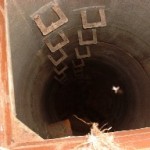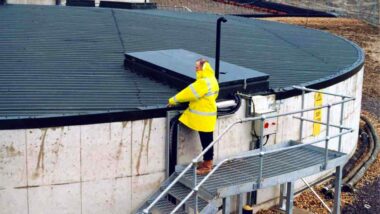 The subject of leachate collection and extraction embraces:
The subject of leachate collection and extraction embraces:
- the wells and boreholes within the landfill into which the leachate collection system conveys the leachate;
- the pump systems which extract the leachate from the wastes;
- the systems which deliver the motive force to the pumps;
- the pipes/pipelines which convey the leachate to the collection tank, or treatment plant location;
- the monitoring and control systems.
Given the breadth of skills required to successfully achieve the extraction of leachate it is therefore not surprising that over the past 15 to 20 years since the emergence of the fully engineered landfill, a number of specialist leachate extraction contracting organisations have grown up, to fill the demand for these skills.
Existing technologies and products from closely allied fields have been refined in recent years, and new products have been, and continue to be, developed in this industry. There is now a recognised range of technologies and products which are currently applied to leachate extraction.
These products are put to the test when applied to landfill sites where leachate levels have risen and must be drawn down rapidly. Such was the case in 2002 when the Arpley landfill was drawndown using pneumatic extraction pumping systems. The work is described in a paper by Howard Robinson, which was presented at the CIWM’s Annual Waste Management Exhibition and Conference, Torbay, June 2003. This paper describes how the Arpley Landfill Site has was transformed in terms of leachate collection and extraction with excellent leachate level control to become a fully compliant site in all leachate management aspects.
Leachate Extraction Wells & Boreholes
The types of wells regularly utilised in leachate extraction systems are characterised as follows (listed in the approximate order of their first introduction):-
- massive engineering structures in the form of rigid towers extending full height to the restored surface, and which were built during the late 1980 and early 1990’s to enable at least two dozen very deep vertical sided quarries to be infilled and continuously drained by pumping. A classic example is the Enderby Warren Quarry Landfill, Leicestershire, UK which is some 80 metres deep, and houses pumps to handle in excess of 300m³/day of leachate;
- the most commonly used have been precast concrete chamber rings, in sizes between 600 mm and 1.8 m diameter, (sometimes larger) which were progressively raised with each lift of the waste, and into which electric pumps were most often inserted;
- percussion driven boreholes, retrofitted into the waste, lined in drainage stone/filter textile and cased, before a pump is installed. Casings are normally steel initially but these can often be removed and replaced with plastics and stone packing may be added to act as a drainage and filter medium;
Proprietory HDPE well systems based upon designs initially developed initially in Germany, have been used on a number of UK sitefor the alst 20 years . These systems are raised progressively with the waste in much the same manner as is most commonly done with circular precast concrete (pc) wells. Being made from this corrosion free plastic material the proprietory HDPE well systems are capable of withstanding greater settlement than pc, and are not prone to deteriorate due to the chemical action of leachate.
Upslope risers are wells laid at an inclined angle to battered side slopes of landfills. Such slopes have become common features, including in steep sided quarries where they are needed to support the landfill lining materials. Upslope risers are often assumed to suffer less from settlement damage than vertical wells, and the possibility arises, that a roddable through-connection may be feasible into the leachate collection basal under-drains, enabling the possibility of cleaning the leachate under-drainage system.


Hello…
Our experience shows that side-slope risers suffer just as much (if not more) from settlement issues than vertical chambers / wells. Pneumatic pumps have their uses but require a lot of maintenance (they are prone to stalling, blockages and scale build-up. Additionally, they are not much good if substantial flows are required as flow rates are poor. (Give me an ATEX-approved electric pump anytime)!!
Regards,MH
I was surprised to see the concrete ring leachate well image : reminded me of a dual skilled bulldozer driver I met in the 1990s : he was tasked with sampling the leachate and his bailer had got stuck. Being untroubled by HSE procedures and relevant training he climbed down inside the well using the metal steps to try to retrieve his sampling equipment …. and I quote :
” you cant breave dahn there y’know…its dangerous…”
If there is one singular “takeaway message ” here it is ;
” The only success criteria for all your HSE / PTW procedures is what front line staff actually do under low or zero supervision conditions ( night-time and weekends especially ). “